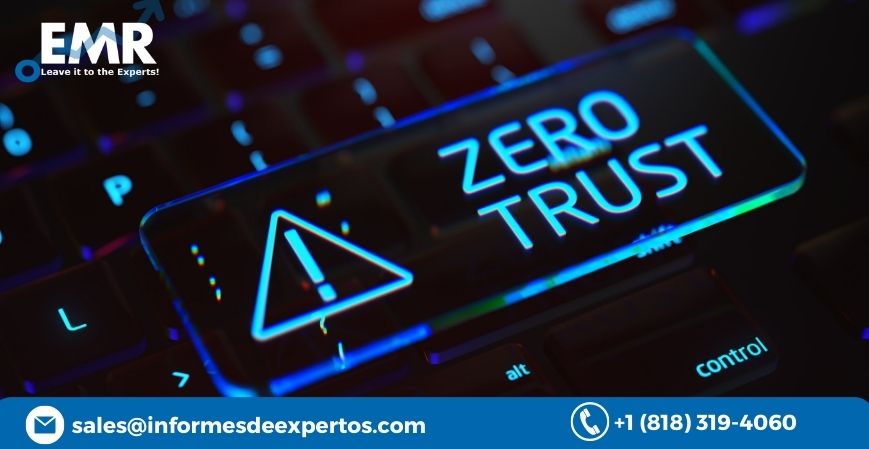In an era where cybersecurity threats are constantly evolving and escalating, the zero-trust security model has emerged as an effective solution. The global Zero Trust Security market achieved a substantial value of about USD 22.99 billion by 2021. Fueled by ever-increasing cybersecurity threats and the need for robust solutions, this industry is anticipated to grow at a Compound Annual Growth Rate (CAGR) of 17.30% between 2023 and 2028. Consequently, the market value is projected to reach nearly USD 59.89 billion by 2027, marking a significant shift in global security paradigms.
What’s the Overview of the Zero Trust Security Market?
The zero trust security model operates on the principle of “never trust, always verify.” It assumes that breaches can occur from anywhere, both inside and outside the network, and hence, trust must be entirely removed from the system. All users, even those inside the organization’s network, must be authenticated and authorized before gaining access to applications and data.
The zero trust model provides a holistic approach to security, encompassing several technology areas such as network security, data security, security and risk management, and more. The advent of this security model has significantly impacted businesses worldwide, with many industries shifting to this more rigorous, comprehensive security approach.
What are the Components of the Zero Trust Security Market?
The zero-trust security market comprises several critical components:
- Network Security: This involves implementing zero-trust principles to protect network layers from attacks.
- Data Security: This facet ensures data is encrypted and only accessible to verified users.
- Security and Risk Management: This component involves evaluating risks and implementing a zero-trust model to mitigate them.
- Security Analytics and Automation: This includes the use of AI and machine learning to identify abnormal behavior or breaches in the system and automate the response.
- Identity and Access Management (IAM): This crucial component ensures that only authenticated and authorized users can access certain data and applications.
Market Segmentation
The zero trust security market can be segmented based on solution type, deployment type, organization size, industry vertical, and geography. Solution types can be broken down into network security, data security, security, and risk management, security analytics and automation, and IAM.
The deployment type is divided into cloud and on-premises. Organization size includes small and medium-sized enterprises (SMEs) and large enterprises. Industry verticals utilizing zero trust security include IT and telecom, healthcare, BFSI, government, retail, and more.
Geographically, the market spans North America, Europe, Asia-Pacific, and the rest of the world. Each region contributes significantly to the overall market growth due to its unique cybersecurity needs and regulatory environments.
Benefits and Applications of Zero Trust Security
The zero-trust security model offers numerous benefits. It mitigates the risk of insider threats, reduces the attack surface, provides visibility and control over the network, and ensures compliance with various regulations.
In terms of applications, zero trust security can be used across many industry verticals. These include IT and telecom, where sensitive data needs to be protected; healthcare, where patient data privacy is crucial; government sectors, where national security data requires stringent protection; and BFSI, where financial data is at high risk of cyber attacks.
What are the Factors Driving the Zero Trust Security Market?
The growth of the zero-trust security market can be attributed to several key factors. The increasing frequency of cyber-attacks, escalating concerns about data privacy, the proliferation of cloud services, and the rise of remote work environments are all contributing to the demand for zero-trust security solutions.
Furthermore, regulatory bodies are imposing stringent data protection laws, leading to an increased adoption of the zero-trust security model. The growing recognition of insider threats and the need for a more comprehensive and preventative approach to security are also driving this market.
Challenges and Barriers in the Zero Trust Security Market
Despite the increasing adoption of the zero-trust security model, the market faces several challenges. Implementing a zero-trust architecture can be complex and require significant time and resources, which can be a barrier for some organizations.
Moreover, the lack of awareness and understanding of the zero trust model, especially in emerging markets, can limit its adoption. There’s also a shortage of skilled professionals in the field, which could potentially hinder market growth.
Market Opportunities and Future Outlook
The future outlook for the zero trust security market is positive, with ample growth opportunities ahead. With an increasing number of businesses moving their operations to the cloud and the rise of the remote workforce, the need for robust, reliable, and efficient security models like zero trust will only grow.
Emerging technologies such as AI and machine learning are set to revolutionize the market, offering automated and intelligent security solutions. Furthermore, the development of stringent regulatory standards across various regions will continue to drive the need for comprehensive security models like zero trust.
In conclusion, the zero trust security market is poised for significant expansion over the next few years, propelled by the escalating need for stringent security measures in a world increasingly driven by digital technologies. Despite facing several challenges, the market is set for a bright future, thanks to technological advancements, evolving corporate practices, and heightened awareness of cybersecurity issues.
You may also like
-
How Does Plywood HSN Code Decide the GST Rate for Traders and Manufacturers?
-
POS Terminal Type: Which Is Best for Your Business?
-
How to Choose Fixed and Portable Gas Monitors for Industrial Gas Detection?
-
Simplifying Trademark Registration in Hong Kong: What Businesses Need to Know
-
EPR Registration and Annual Returns Explained: Compliance Made Simple for Businesses

